Situated in modern-day Tunisia, the Carthage Archaeological Site stands as a testament to the ancient civilization that once thrived in the Mediterranean. With its rich historical significance, Carthage has long fascinated scholars and historians, serving as a formidable rival to Rome and shaping the course of Western history.
The truth of its grandeur and influence is evident as one explores the architectural marvels within the site. From the remarkably preserved Roman Theatre to the intricate mosaics of the Antonine Baths, Carthage’s splendor is undeniable. On top of that, its multicultural heritage, reflected in its artistry and craftsmanship, continues to captivate visitors.
Ongoing excavations and preservation efforts have unveiled a wealth of artifacts, allowing us to delve deeper into the mysteries of this ancient city.
Good To Know
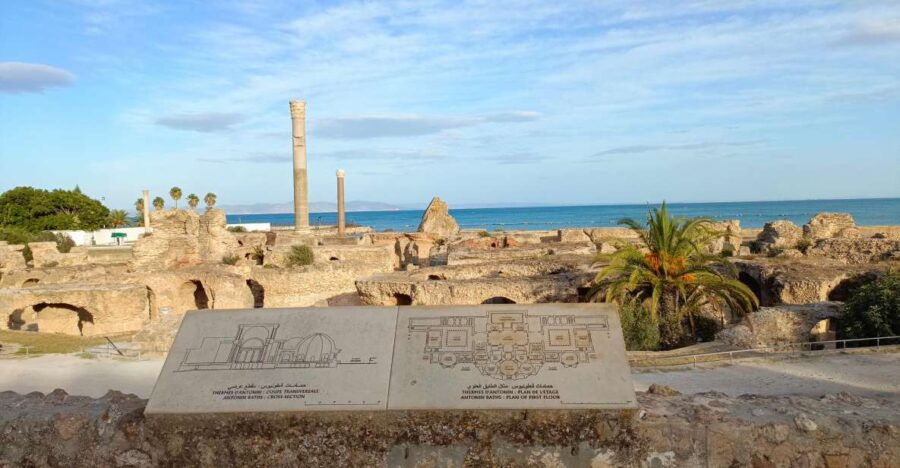
- Carthage was a powerful ancient civilization and a major rival of Rome.
- The archaeological site of Carthage showcases impressive ruins and structures.
- Carthage was a multicultural city with influences from Phoenician, Roman, and African cultures.
- Carthage has been designated as a UNESCO World Heritage site.
Historical Significance of Carthage
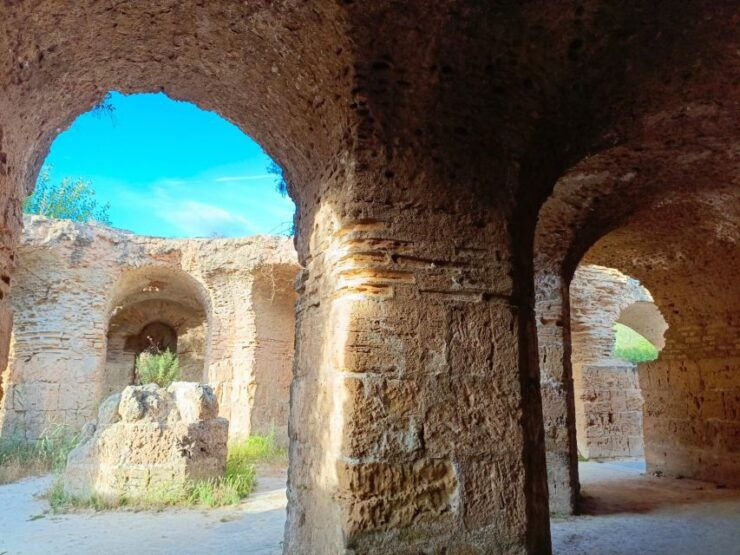
Carthage, a once-powerful ancient civilization, played a significantly influential role in Mediterranean trade and warfare, often engaging in conflicts with Rome.
Its impact on Mediterranean trade can’t be overstated, as Carthage established a vast network of commercial routes and dominated the maritime trade in the region. The city’s advanced naval technology and strategic location made it a formidable force in the Mediterranean.
However, it was the Punic Wars, a series of conflicts between Rome and Carthage, that ultimately shaped the course of Western history. These wars resulted in the destruction of Carthage and the rise of Rome as the dominant power in the Mediterranean.
The consequences of the Punic Wars were far-reaching, leading to the spread of Roman influence and the decline of Carthaginian civilization.
Find more activities and experiences we've covered in Tunis.
Architectural Marvels at Carthage
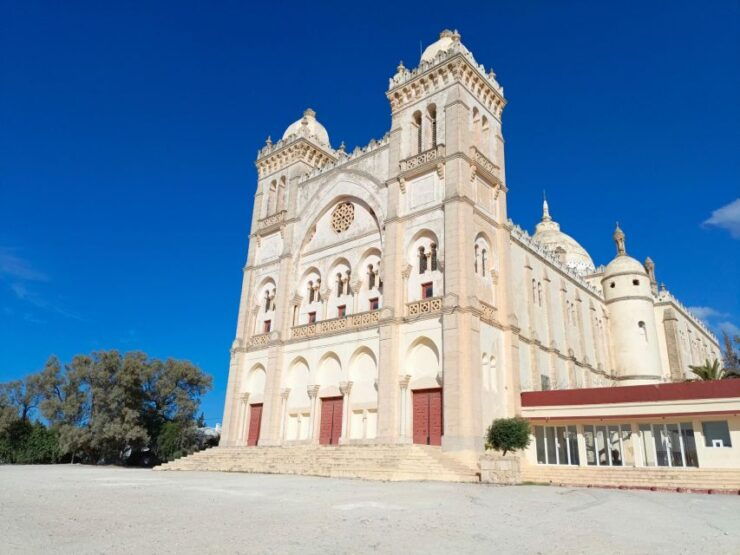
The archaeological site of Carthage boasts a collection of impressive ruins and structures that highlight the architectural marvels of this ancient civilization.
One of the notable structures is the Roman Theatre of Carthage, a well-preserved amphitheater that once hosted various entertainment events. Visitors can imagine the grandeur of ancient performances as they explore the theater’s seating areas and stage.
Another fascinating aspect of Carthage’s architectural heritage is the Tophet, an ancient burial ground. Exploring the Tophet provides insights into Carthaginian religious practices, particularly their beliefs surrounding death and the afterlife.
Plus, the site showcases the Antonine Baths complex, an example of Roman engineering excellence. This complex features intricate mosaics and provides a glimpse into the luxurious bathing rituals of the time.
Carthage’s architectural marvels offer a captivating window into the rich history and cultural legacy of this ancient civilization.
Cultural Heritage of Carthage
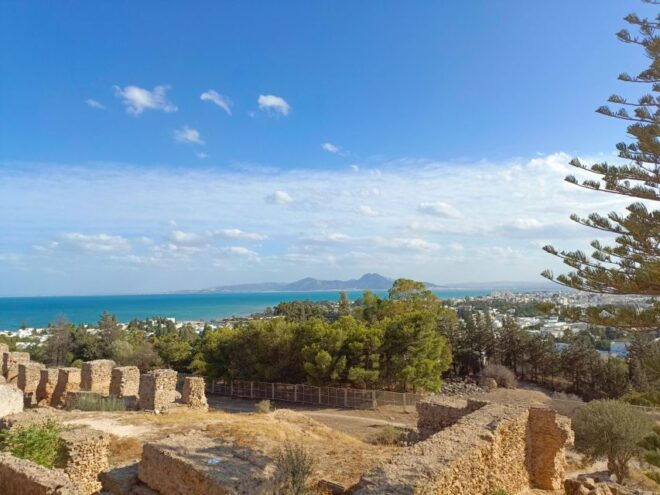
A multicultural city with influences from various cultures, Carthage’s cultural heritage is a testament to its rich history and diverse traditions. The city’s art and craftsmanship reflected a blend of different traditions, showcasing the unique skills of Carthaginian artisans.
Carthaginians were known for their exceptional production of textiles, pottery, and metalwork, which exemplified their mastery of various artistic techniques. Along With their artistic prowess, Carthaginian religious practices played a significant role in shaping their cultural identity. With a pantheon of deities and intricate rituals, including animal sacrifices, Carthaginian religious practices were deeply ingrained in their society.
Today, remnants of Carthaginian art, craftsmanship, and religious practices can be seen in the archaeological finds and artifacts that have been unearthed at the Carthage site, providing valuable insights into the city’s vibrant cultural heritage.
Archaeological Discoveries at Carthage
Archaeological excavations at the site of Carthage have revealed significant discoveries that shed light on the ancient civilization’s history and daily life. These excavations have uncovered ancient tombs, temples, and residential areas, providing valuable insights into Carthaginian society. Let’s take a closer look at some of the notable findings:
| Ancient Tombs | Temples | Residential Areas |
|---|---|---|
| El Kram Necropolis: A vast burial ground with over 2,000 tombs, showcasing various burial practices of the Carthaginians. | Temple of Eshmun: Dedicated to the Phoenician god of healing, this temple features intricate carvings and is a testament to Carthage’s religious beliefs. | Punic Houses: Excavations have unearthed well-preserved residential areas, giving us a glimpse into the everyday lives of Carthaginians. |
| Byrsa Hill: This area contains several tombs, including the Tomb of the Barcid, which is believed to be the final resting place of important Carthaginian leaders. | Temple of Melqart: Dedicated to the Phoenician god of Tyre, this temple was a center of religious and political activity in Carthage. | Tophet: A sacred area used for child sacrifices, the Tophet provides insights into Carthaginian religious practices. |
| Punic Port: The remains of this ancient harbor reveal the city’s maritime infrastructure and highlight its importance as a trading hub. | Temple of Ba’al Hammon: Dedicated to the chief god of Carthage, this temple was a center of religious worship and cultural significance. | Amphoras: Excavations have uncovered a large number of amphoras, indicating the city’s active trade network and economic prosperity. |
These discoveries not only enhance our understanding of Carthage’s ancient civilization but also bring to life the rich history and cultural heritage of this remarkable city.
More Great Thing To Do NearbyPreservation Efforts at Carthage
Preservation efforts at Carthage have been instrumental in safeguarding the archaeological site’s historical treasures and ensuring their long-term survival. The use of various preservation techniques and community involvement has been crucial in maintaining the integrity of the site.
Here are five key aspects of the preservation efforts at Carthage:
Conservation and restoration: Skilled experts employ conservation methods to repair and protect the fragile ruins and artifacts, ensuring their longevity.
Site maintenance: Ongoing maintenance activities, such as regular cleaning and monitoring, help prevent deterioration and damage caused by natural elements.
Education and awareness: Community involvement plays a vital role in raising awareness about the importance of preserving Carthage. Educational programs and initiatives help foster a sense of ownership and responsibility among locals and visitors alike.
Sustainable tourism practices: Measures are implemented to balance the influx of travelers while minimizing environmental impact. Guided tours and visitor regulations ensure the preservation of the site’s fragile remains.
Collaborative partnerships: Collaboration between archaeologists, historians, government agencies, and local communities helps develop comprehensive strategies for the sustainable preservation of Carthage.
- NEW: Enjoy Sidibousaid, Medina and Delectable Tunisian Fare
- Traditional Tunisian Cuisine Cooking Class in Tunis
- Tunis Carthage Airport (TUN): Transfer to Port La Goulette
- From Tunis: Hammamet and Nabeul Tour
- Tunis: 3-Day Sahara Explorer Guided Tour With Meals and Transfer
- From Tunis: Oudhna, Testour, Djebba, and Dougga Day Tour
Carthage as a UNESCO World Heritage Site
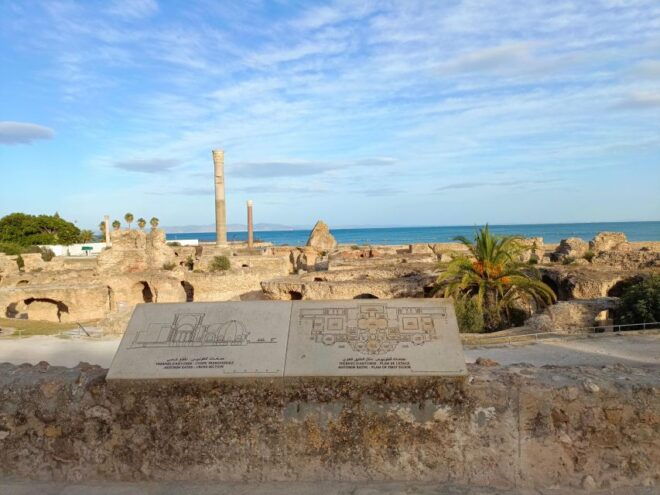
Carthage’s designation as a UNESCO World Heritage site highlights its exceptional historical and cultural significance. This prestigious recognition has brought attention to the preservation challenges faced by this ancient archaeological site. Efforts have been made to protect and restore the ruins, ensuring that future generations can appreciate and learn from Carthage’s rich past.
The impact on the local economy has been significant, with the influx of travelers from around the world. The site attracts history enthusiasts who are eager to explore the remnants of this once powerful civilization. Guided tours offer visitors a chance to explore Carthage’s fascinating history, while supporting the local economy through tourism.
Carthage’s status as a UNESCO World Heritage site not only preserves its heritage but also provides a boost to the surrounding community.
Tourism at Carthage
Tourists at Carthage can explore the ancient ruins and enjoy the rich history of this renowned archaeological site. Here are some of the tourist activities and experiences that await visitors:
Guided Tours: Knowledgeable guides lead visitors through the ruins, providing fascinating insights into Carthage’s past. They highlight significant landmarks and share stories of the ancient civilization.
Museum Visits: The Carthage National Museum houses a vast collection of archaeological finds, including artifacts, statues, and mosaics. It offers a deeper understanding of Carthaginian culture and daily life.
Panoramic Views: Climbing the Byrsa Hill rewards visitors with breathtaking panoramic views of the surrounding area. It’s a perfect spot to appreciate the city’s strategic location and architectural wonders.
Local Cuisine: Exploring Carthage wouldn’t be complete without indulging in the local cuisine. Visitors can savor traditional dishes like couscous, brik, and tagine, which showcase the flavors and influences of the region.
Shopping: Carthage offers a variety of shops and markets where travelers can purchase souvenirs, handicrafts, and locally-made products. It’s a great way to bring a piece of Carthaginian culture home.
With its historical significance, architectural marvels, and cultural heritage, Carthage offers a truly unforgettable experience for travelers.
Experiencing the Wonders of Carthage
Visitors to Carthage can enjoy the wonders of this ancient archaeological site. Carthage’s impact on Mediterranean trade and the influence of Phoenician culture on Carthaginian society are evident in the artifacts and structures that have been uncovered. The ruins of Carthage offer a glimpse into a civilization that was once a powerful rival to Rome.
| Architectural Marvels | Cultural Heritage | Archaeological Discoveries |
|---|---|---|
| – Roman Theatre of Carthage, a well-preserved amphitheater | – Multicultural city with influences from Phoenician, Roman, and African cultures | – Unearthed ancient tombs, temples, and residential areas |
| – Antonine Baths complex, an example of Roman engineering with intricate mosaics | – Blend of different traditions in art and craftsmanship | – Ruins of the Punic Port, displaying maritime infrastructure |
| – Tophet, an ancient burial ground providing insights into Carthaginian religious practices | – Skilled traders known for textiles, pottery, and metalwork | – Valuable insights into Carthaginian daily life and urban planning |
| – Byrsa Hill, offering panoramic views and remnants of ancient buildings | – Carthaginian religion with a pantheon of deities and rituals | – Carthage National Museum housing a vast collection of archaeological finds |
Preservation efforts have been made to restore and protect Carthage’s archaeological remains, with the site being designated as a UNESCO World Heritage site. Tourists from around the world are drawn to Carthage to explore the ruins and learn about the fascinating history of this ancient civilization. It is an opportunity to experience firsthand the wonders of a civilization that shaped the course of Western history.
Common Questions
What Were the Main Causes of the Punic Wars Between Rome and Carthage?
The main causes of the Punic Wars between Rome and Carthage were territorial disputes, economic competition, and political tensions. These conflicts had far-reaching effects on both civilizations, shaping the course of Western history.
How Did Carthaginian Architecture Differ From Roman Architecture?
Carthaginian architecture differed from Roman architecture in several ways. The Carthaginians incorporated influences from Phoenician and African cultures, resulting in unique designs. Comparatively, Roman architecture drew inspiration from Greek and Etruscan styles, showcasing grandeur and engineering excellence.
What Were the Major Deities Worshipped in the Carthaginian Religion?
The major deities worshipped in the Carthaginian religion were Ba’al Hammon, Melqart, and Tanit. These gods and goddesses played significant roles in Carthaginian religious beliefs and rituals, including animal sacrifices and fertility rites.
What Is the Significance of the Artifacts Found in the Ancient Tombs at Carthage?
The artifacts found in the ancient tombs at Carthage hold great significance. They offer valuable insights into Carthaginian culture, religious practices, and daily life. These relics are a testament to the rich and diverse heritage of the ancient city.
Are There Any Ongoing Archaeological Excavations or Research Projects at Carthage?
Yes, there are currently ongoing excavations and research projects at Carthage. Archaeologists are uncovering new artifacts and evidence, shedding light on the ancient city’s history and providing valuable insights into Carthaginian culture and daily life.
The Sum Up
To sum it up, Carthage Archaeological Site stands as a testament to the ancient civilization that once thrived in the Mediterranean. Its historical significance, architectural marvels, and rich cultural heritage make it a captivating destination for explorers and history enthusiasts alike.
Ongoing archaeological discoveries and preservation efforts ensure that the wonders of Carthage continue to be unveiled and appreciated by visitors from around the world. It’s a truly remarkable place where the past comes alive, offering a unique and immersive experience of an extraordinary civilization.
You can check if your dates are available here:More Tour Reviews in Tunis
- 6 Days Berbers and Diars by 4 Wheeler From Tunis
- 3 Day Tour of Dahar Mountains From Tunis Sousse
- 1 Day Trip to the Medina of Mahdia From Tunis or Hammamet
- Full Day Private Shore Tour in Tunis From La Goulette Cruise Port
- Full Day Private Shore Tour in Tunis From La Goulette Cruise Port
- Tunis Private Transfer From Tunis Carthage (Tun) Airport to Mahdia
Looking for something different? Other Tunis activities we've written about
- 14 Best Guided Tours In Tunis
- 25 Best Tours In Tunis
- Best Workshops And Classes In Tunis
- 8 Best 3 Day Tours In Tunis
- 5 Best Full-Day Tours In Tunis
- Best 2 Day Tours In Tunis
- 20 Best Private Driver Services In Tunis
- 19 Best Airport Transfers In Tunis
- 15 Best Guided Tours In Tunis
- Best Boat Tours And Cruises In Tunis
- 2 Best 4 Day Tours In Tunis
- 5 Best City Tours In Tunis
